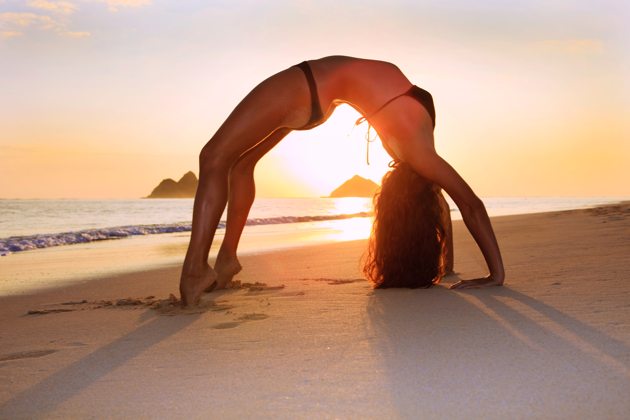For many years, backbends were my nemesis. I just couldn’t get comfortable once I was in them. Never mind actually paying attention to the teacher’s instructions while in the pose.
As soon as I would move into deeper backbends like Wheel (Urdhva Dhanurasana) or Bow (Dhanurasana), my neck would hurt, my upper back and shoulders felt tight, and my lower back was silently complaining.
By the time the teacher would cue us to come down, I was gritting my teeth and shaking from the effort it took to be in the pose. Peace was the last thing on my mind.
Why not open your heart?
But I knew I would be missing out if I gave up and skipped backbends altogether. Backbends have a lengthy list of perks after all.
When done mindfully, they strengthen the spine as well as open and lengthen the front body, from the chest to hip flexors and legs. These poses improve breathing, your posture, and stimulate digestion. And most active backbends are invigorating and heating too.
With all of these benefits, it’s not a far leap to see why these poses are also said to counteract fatigue and depression. Backbends kind of rock, really.
Not just about the back… Or the core
Yet, as simple as backbends may appear, they can be rather involved poses.
A backbend is not just about bending your spine. You might have heard that the key to a healthy back lies in a healthy core. Indeed, there is a direct relationship between the abdominals and spine—your core enables movement and supports your trunk.
Before you decide on crunches as your remedy for back pain, however, you might be surprised to learn that there are better ways to strengthen your backbends.
In addition to abs and obliques, your legs, hips, chest, and shoulders often need to actively contribute as well, in order to cultivate a sustainable, healthy backbend.
In a backbend, your legs and hips anchor and stabilize the pose, while the trunk and shoulders distribute the extension to the upper back, where the spine is usually less backbend-y. When all these parts work together with an engaged breath, your backbends become freer, happier, and more enriching.
Did that pesky, crunchy feeling get in the way?
Most of the back pain questions I get center around the low back, or lumbar spine, in backbends. If there isn’t an existing back problem, low back pain more often develops because the tendency is to rely overly on the lumbar spine to take the pressure of the backbend.
In a pose like Wheel, Bow, or deeper variation of Cobra (Bhujangasana), for example, this can look like an even more excessive arch in the lower back.
This kind of uneven distribution of the back extension usually leads to compression in the spine—what I like to call that crunchy feeling where bone meets bone.
Without proper alignment in a backbend, the spinal discs cushioning each vertebra get exceedingly squeezed towards the front of the spine, leading your spinous processes (the bony ridges you feel running your hand down your spine) to grind against each other, wearing down the bones, i.e. crunch.
If this happens too often, the risks can include chronic back pain or other serious related injuries. So to avoid this sad state of affairs for your low back, here are some quick tips to help enjoy a happier backbending journey.
1. Work from the ground up.
One of my teaching mentors would say, in order to improve a yoga pose, it’s best to start from the ground up, in most cases from your feet and legs.
If you’ve dealt with low back pain in your backbends, start firming your leg muscles and roll your thighs inwardly as though you were squeezing a yoga block between them. This reduces stress to the sacrum, which can come from too much outward or external rotation in the legs.
2. Grow taller and lengthen.
It’s easy to see backbends lengthen and stretch the front of your body, but don’t sacrifice your backside.
Instead, gently tone your core and draw your tailbone away from your heart, towards your legs. It’s not so much tucking your tailbone between your legs, but encouraging it to lengthen away to release any excess pressure on the vertebrae.
3. Defy gravity and fall up!
I like to think of the image of a hot air balloon here, gently rising up with the help of carefully choreographed bursts of air.
As you lengthen the spine, try to maintain expansive breaths that open the lower back ribs so your back body stays full and eases pressure to the lumbar spine. These breaths will also help encourage you to keep your chest full and the shoulders rolling away from the ears.
When the shoulder blades slide more easily towards the spine and waist, you can better support the extension in the upper back. You might even get a sense of falling upwards to arch back.
Ultimately, your backbends should invite spaciousness throughout your whole body—not just specific parts. May you experience an open heart and happy spine!


